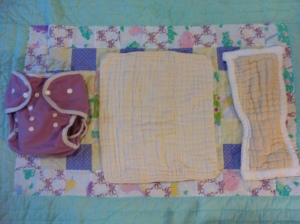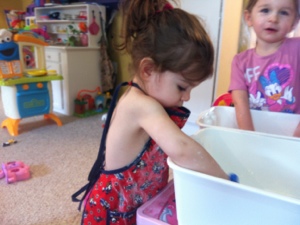
Sorry for my delay in posting anything for the past week, it has been BUSY around here. The husband is in ‘crunch time’ mode with work, and my littlest one has had an ear infection and is also getting her last few teeth (my poor girl!). On a side note, garlic oil works WONDERS for ear infections (no antibiotics or doctor’s visit this time, hooray!). We made our own garlic oil on our double boiler (thanks to a recipe from my wonderful Aunt!). We crushed a few cloves, covered them in olive oil, and left them on the stove for about an hour (just check the double boiler constantly to make sure the water in the bottom hasn’t boiled dry). And make sure you let it cool before using! We used a few drops in each ear a few times a day. This was Good Friday so all the stores were closed, we were lucky enough to have all the supplies we needed! Then, on Saturday, we bought St. Francis Herb Farm’s Ear Oil, which contains Mullein, Calendula, Garlic and St. John’s Wart (we found it at our local natural vitamins and supplements store), and used that for about a week 3 times a day. I’ve never seen an ear infection clear up so quickly! God gives us such wonderful things to heal our bodies naturally, it’s a shame that we so often rely upon chemicals that have nasty side effects to do so instead.
Ok, so my side note is done! On to the real topic of this post, natural baby care, specifically natural baby wash/shampoo. This will be the topic of my blog posts for the next little while, so if you don’t have little ones, you may know someone with little ones, or may have them yourself in the future, so listen up!
Think of how small and fragile a baby is, especially a newborn, and think of how very sensitive and vulnerable these little ones’ systems are, how much more will they be affected by toxins in our world? I think that for this reason, we must be extremely careful about what we expose them to.
Johnson and Johnson has come out publicly (a few years ago), after prodding from consumers and others, to affirm the presence of carcinogens in its baby washes and shampoos. The company says that they are slowly phasing out these chemicals (however I just checked the ingredient list to their shampoo and baby wash and these carcinogens are still present), when they will be completely phased out, I don’t know.
An article about the topic notes that ‘for the past two years, health and environmental groups have been urging Johnson and Johnson to remove two potentially cancer causing chemicals from its baby shampoo. One of these ingredients is quaternium-15, which releases formaldehyde, a skin, eye, and respiratory irritant, and a known carcinogen (formaldehyde exposure has been associated with leukemia specifically)… The other, 1,4 dioxane, is a likely carcinogen… according to the CDC, 1,4 dioxane is ‘probably carcinogenic to humans’, and is toxic to your brain, central nervous system, kidneys and liver”. I have just taken out a few quotes from this article, but if you want to read the entire thing (it is very informative) you can find it at http://articles.mercola.com/sites/articles/archive/2011/11/14/johnson-johnson-baby-products-toxic.aspx
I do not mean to pick on Johnson and Johnson, as many brands out there are equally guilty of these harmful ingredients in their baby products. The above article lists a number of ingredients to look out for in your baby’s soaps/shampoos that are associated with formaldehyde and 1,4 dioxane as by products. Look out for quaternium-15, DMDM hydantion, Imidazolidinyl urea, and Diazolidinyl urea which are likely to contaminate products with formaldehyde; and PEG-100 stearate, Sodium laureth sulfate, sodium myreth sulfate, polyethylene, and cetareth-20, which contaminate products with 1,4 dioxane. You can read the whole article (link posted in the above paragraph) for a more extensive list of ingredients to avoid.
I admit it, I am guilty of using Johnson and Johnson baby products in the past with my little ones, as I was completely ignorant of its ingredients, and completely trusting in it’s “#1 Choice of Hospitals” tagline and, well, it’s reputation as a ‘family company’. After I found all of this out, I felt almost double-crossed with this misrepresentation. I’m happy to say, however, that I have changed my ways and now use ONLY non-toxic soaps for my two little ones. Instead of paying tons for the ‘natural’ brands, however, I make my own (which is cheaper (BONUS!), and I can control exactly what goes into it (no sneaky ingredients!).
A word of caution, my formula is NOT TEAR FREE, so avoid getting it in baby’s eyes. The reason it is not tear free is because tear free does not equal gentle but instead means it probably is quite the opposite and just contains chemicals that temporarily numb or paralyze baby’s tear ducts to the sting of the harsh chemicals.
Foaming Baby Wash
– You will need a foaming soap dispenser (you can usually find one at your local dollar store, grocery store, or wherever it is that you do your shopping. Just empty out the toxic soap inside and wash it out REALLY well, and refill it with your non-toxic baby soap).
– 1/4 cup Dr. Bronner’s unscented baby mild liquid castile soap (if you are using a really small dispenser, use a little less, it’s really concentrated).
– Enough water to fill the rest of the soap dispenser.
I chose a foaming soap dispenser because this soap is really watery and not really sudsy, so the foaming dispenser makes it nice and ‘soapy’. You can use essential oils if you want, but they can irritate sensitive skin, so I choose to leave them out. Lavender, however, is a fairly mild one though, so if you choose to use essential oil, I would recommend lavender (only a little bit though!).
That’s it! Easy, cheap, and non-toxic! Dr. Bronners can be pricey (we buy it for $17.99 CAD a bottle, but the bottle is HUGE and it takes a long time to go through, so it actually saves us money in the long run).
Next time I will talk a little bit about baby bum care, until then, stay away from those harmful bum creams!







Recent Comments